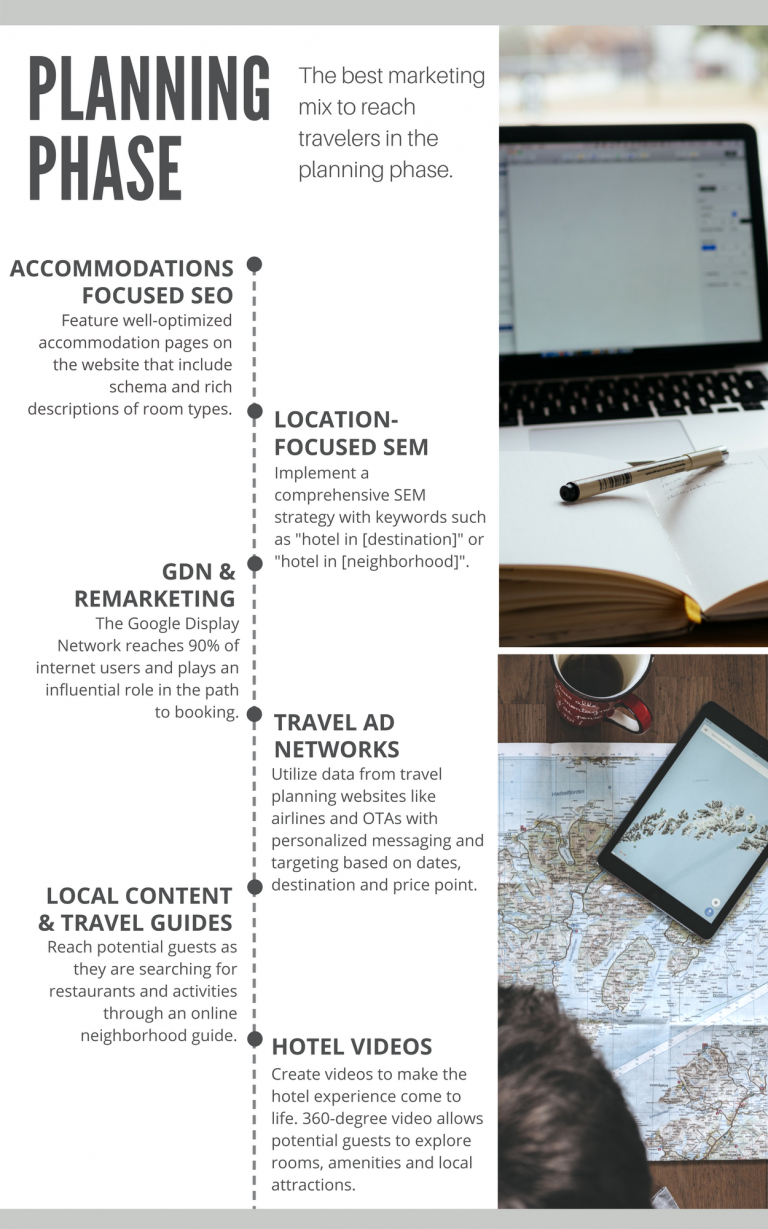
By Margaret Mastrogiacomo, VP Strategy
This article is part three in a five-part series that uncovers top strategies for reaching potential guests in meaningful moments throughout every stage of the travel planning journey to increase direct bookings. This article focuses on the second stage of travel planning: the planning phase.
The moment you decide to take the plunge on planning a vacation can be just as exciting as the vacation itself. Once someone chooses a travel destination, the dreaming phase starts to become a reality, setting the travel planning phase in motion.
Read on for part three of our five-part series titled, “How to Capitalize on the Full Travel Planning Journey to Drive Direct Bookings” to understand how hotel marketers can reach potential guests in the planning phase of the online travel journey. We will uncover what online behaviors are most common in this stage, what marketing channels are most effective, and how to measure success.
What exactly is the planning phase?
The second stage of travel planning is the planning phase when consumers have decided on a destination and start planning the details of their trip. Google refers to the micro-moments throughout this phase as “Time-to-Make-a-Plan” moments, where consumers’ begin researching transportation, flights, hotel accommodations, and vacation activities.
According to Google, in this stage, mobile devices are playing a critical role with more than one in three travelers agreeing that when researching on their smartphones, they've discovered a new travel company.
Millennials are Mobile in the Planning Phase.
The statistics are even greater among millennial travelers with 50% reporting they discovered a new travel company while researching on mobile. Today, travel planning across devices is becoming second nature with leisure travelers now being just as likely to plan travel on their smartphone as they are to shop for music. This shift to mobile in the planning process means marketers need to rethink how they are delivering content and engaging with potential guests throughout this phase.
What digital touchpoints are making an impact throughout the planning phase?
By now you should have already reached potential guests throughout the dreaming phase to influence important travel planning decisions. But, if you aren’t already in the consideration set at this point in the journey, reaching travel consumers in key research and planning micro-moments is your chance to make an impact. So, what exactly do these micro-moments look like throughout the planning phase?
A study conducted by Think with Google has confirmed that the majority of time spent throughout the planning phase is:
- OTAs: 10%
- Maps: 24%
- Events & Activities: 13%
- Search: 19%
- Transportation: 9%
- Accommodation: 4%
- Restaurant: 11%
- Other: 10%
With almost half of research taking place on search engines and maps, having a strong search strategy throughout the planning phase must be a top priority. While OTAs are still a top resource, according to the Google study results, OTAs played a greater role in the dreaming phase. Now travel planners are simply revisiting OTA websites to price compare the options already on their radar.
So, what type of content are travelers looking for in the planning phase?
During the planning phase, travelers reported that search is the most common way in which they discovered the brand they ultimately booked. People want brands to provide content to inspire and to help narrow down the area in the destination they wish to stay, accommodation options, and vacation activities. The most common searches in this phase are keywords surrounding accommodations and transportation:
- Hotels in [Destination]
- Car rentals in [Destination]
- Flights to [Destination]
Interestingly enough, some searches, like hotels with a specific type of amenity, are primarily happening on smartphones. "Hotel with an indoor pool" and "hotel with jacuzzi in room" are two of the top hotel amenity searches on smartphones. In fact, 70% of these types of hotel accommodation searches are happening on mobile, revealing just how important it is for hotel marketers to make their accommodations come to life across devices and on smaller screens.
The best marketing mix to reach travelers in the planning phase:
- SEO with a Focus on Accommodations: Be sure to feature well-optimized accommodation pages on your hotel website including hotel schema and rich descriptions of your room types and amenities. Each room type should ideally have its own dedicated landing page within your accommodations section with a visually engaging fully-responsive way to aggregate room types to be prominently displayed on your website or homepage. HEBS Digital offers a Rooms Showcase Module that allows hotels to display room types in a highly-visual, engaging way that puts a spotlight on room amenities, room size, views, and more. Each room type also has its own dedicated image gallery to better aid travelers in the planning process.
- Hotel Location-Focused SEM: With 19% of travel research in the planning phase happening through search engines, it’s important to have a comprehensive SEM strategy across search channels. Hotel location-focused keywords such as “Hotel in [Destination]” or “Hotel in [Neighborhood]” are some of the top searches in this phase. Be sure that search ads for these top keywords are linking to highly relevant landing pages to ensure a high Google Quality Score which will achieve more cost-effective CPCs. Implementing Remarketing Lists for Search Ads (RLSA) is also an effective strategy to reach potential guests who have already been to your hotel website and have shown interest with more relevant messaging throughout search results. Utilizing this targeting strategy, you can also bid more for a higher position in search results since you know this qualified audience is potentially more likely to book.
- Google Display Network & Remarketing: With millions of websites, news pages, blogs, and Google websites like Gmail and YouTube, the Google Display Network reaches 90% of Internet users worldwide and plays an influential role in the planning phase of the path to booking. With an effective targeting, keyword, demographic, and remarketing strategy you can reach more potential guests in relevant micro-moments throughout the planning phase that inspire them to take action.
- Travel Ad Networks: Travel Ad Networks that utilize first-party data from travel planning websites such as airlines, OTAs, and other travel planning resources are a great way to reach potential guests during the planning phase. These display networks allow you to reach users during the travel planning process to your destination with personalized messaging and targeting based on the dates, destination, and price points travel planners are researching. This is one of the best ways to reach guest in the most important planning moments on top travel planning websites with the most useful and relevant information.
- SEO Local Content and Travel Guides: Similar to the dreaming phase, featuring destination and neighborhood guides on the hotel website is one of the best ways to reach potential guests throughout the Planning Phase as travel consumers are searching for restaurants, activities, and things to do. As mentioned in the previous article in this series, HEBS Digital worked with an independent hotel to create comprehensive neighborhood guides surrounding the hotel, and after just 30 days live, 57% of visitors came to the guide from search engines. But these neighborhood guides played an even greater role in the planning phase with 60 bookings initiated in the same timeframe inspiring travel planners to consider booking the accommodations.
- Hotel and Accommodation Videos: Accommodation videos are a great way to make your hotel experience come to life. While destination-focused videos play a major role in the dreaming phase, hotel and accommodation videos help narrow down accommodation choices in the planning phase. 360-degree video is also a great way to allow potential guests to explore rooms. Videos should be no longer than 60 seconds and highlight the overall guest experience, rooms, amenities, and local experiences nearby.
Measuring the Planning Phase: Focus on the KPIs that Count.
In our last article of this series, we covered the top KPIs to focus on in the dreaming phase. Since potential guests engaged in the planning phase of the travel journey have not yet moved into the booking phase, KPIs still remain focused on awareness, traffic, and engagement:
- Impressions/awareness
- Engagement metrics (likes, comments, etc)
- Click-through rate
- Overall website traffic
- Unique website visitors
- Time spent
Overall, reaching travel consumers in the planning phase ensures that you nurture as many potential guests into the booking phase as possible. Your hotel brand should be present throughout at least two to three digital micro-moments with meaningful, relevant messaging within the planning phase to make a significant impact and ultimately win the booking.




